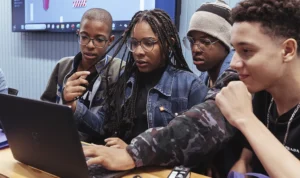Women and black people are the majority in Brazil — they correspond, respectively, to 52% and 56% of the population, according to the PNAD (Continuous National Household Sample Survey) of 2019. But it is still rare to see these groups well represented in the workforce of companies, especially from middle leadership positions. And visibility is even lower when it comes to black people.
To contribute to changing this reality, iFood announced, in 2021, four diversity goals related to women and black people, all to be achieved by December 2023:
- Have 50% of women in leadership (in coordination positions or higher);
- Have 30% of black people in leadership (in coordination positions or higher);
- Have 35% of women in senior leadership (in management positions) head, one above management, or higher);
- Have 40% of black people in the general workforce at iFood.
“iFood is for everyone and, therefore, it needs to be done by everyone, otherwise we will be totally disconnected from the reality of our customers, restaurants and delivery partners”, explains Bel Glezer, from the company's diversity and inclusion team. . “iFood understands that a company of its size has a duty to position itself and promote diversity.”
To reflect, in a very short space of time, the demographic diversity of Brazil among its FoodLovers (as iFood employees are called), the company decided to prioritize women and black people in its initial goals, as the two groups are minorized in spaces of power and company leadership, despite the majority of the population.
“All of this was the result of work that had already been done for a few years and organic movements that emerged among Foodlovers, such as Pólen, which since 2018 has been a partner in the development of the first initiatives in education and engagement in diversity”, says Bel. “Based on these experiences, we began to promote our first institutional actions. Setting clear goals was a way for us to understand where we want to get to and how.”
How are the goals progressing?
Bel states that the goal related to women made great progress in the last two years, thanks to education and awareness initiatives and efforts and to the topic's ambassador leaders, who sought to hire and develop women in their teams. “The percentage of women in leadership went from 20% to 45%, and the percentage of women in senior leadership went from around 10% to 32%”, he reports.
From November 2021 to March 2022, iFood hired 750 black people, but she notes that there are still opportunities to improve further in this regard. “We have also made a lot of progress in these indicators, but we are still not progressing at the speed we want.”
A challenge in this hiring process is the structural barriers to access and professional development. “It is not enough to open an affirmative vacancy program. There are other issues to be addressed so that more people are hired and promoted. Therefore, our strategy is complex.”
In addition to investing in specific hiring and development programs for black people, the iFood diversity team also works with leadership education to fill vacancies and promote employees according to the proposed diversity guidelines and manage a diverse team.
“If on the one hand it is necessary to invest in training, on the other hand it is essential to prepare the environment to welcome women and people of color and train leadership to be aware of their privileges and biases, to practice active listening, to conduct meetings and projects in an inclusive way and knowing how to identify signs of microaggressions, for example”, adds Bel.
Inclusion indicators
At the same time as it defined diversity goals, iFood also developed and started to apply an inclusion indicator (the Psychological Safety Index) to measure whether it offers a psychologically safe environment for people of any gender identity, race or sexual orientation, with or without disabilities.
Created based on the methodology of Dr. Amy Edmondson, from Harvard University, the Psychological Safety Index measures aspects such as a sense of belonging, freedom to express your identity, to disagree, to take risks and to learn.
The difference is that this index applies not only to women and black people, but also to people LGBTQIA+, transgender and disabled. “It’s a way of measuring the feeling of belonging and adherence to the culture of other groups included in iFood’s diversity pillars”, says Bel.
To understand whether there is any inclusion problem in the company and assess the differences between these groups, the Psychological Safety Index of cisgender women and men is compared with that of transgender people; that of LGBTQIA+ people with that of heterosexual people, that of black people with that of non-black people and that of people with disabilities with that of those who do not have disabilities.
iFood’s inclusion goals for December 2023 are:
- Reduce by 50% the difference between the Psychological Safety Index of minority groups and the rest;
- Increase the overall score of the general index to 9 (in May 2021, this average was 8.5; in 2022, the score rose to 8.7).
At iFood, the diversity and culture teams work together so that diversity is present in all employees' experiences in the company. “It’s a culture that recognizes that we are different people and that values and respects these differences,” says Bel. “Diversity is knowing that people don’t fit into boxes and making a continuous effort to include everyone with their complexities and differences.”


